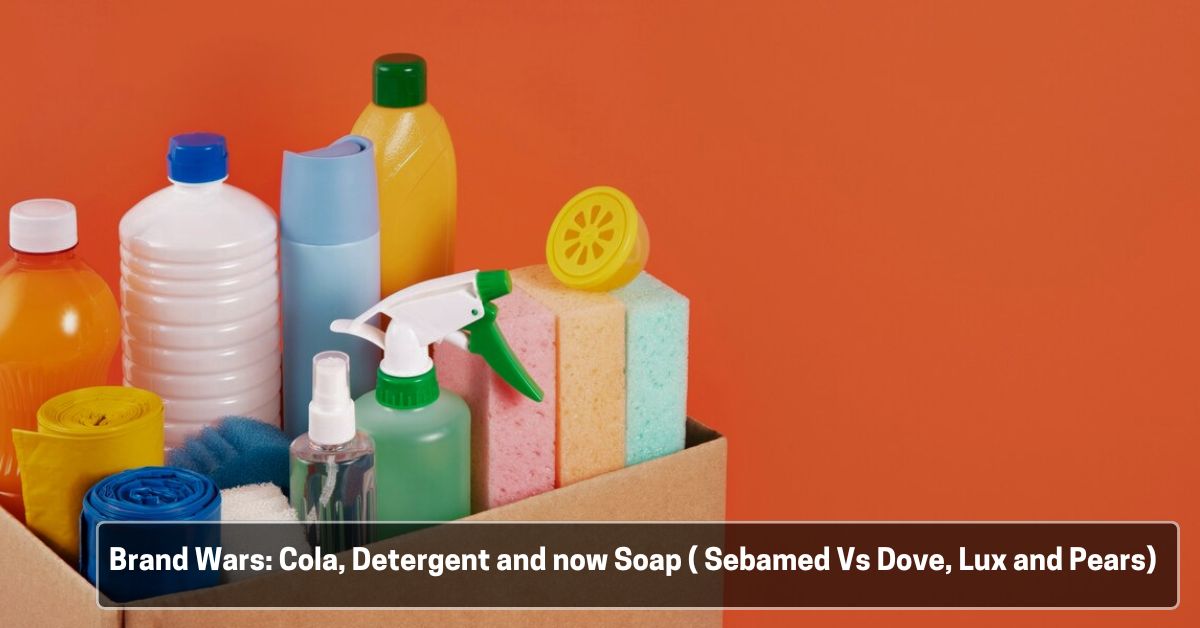Brand Wars: Cola, Detergent and now Soap ( Sebamed Vs Dove, Lux and Pears)

Sebamed, a German personal care brand, in its recent ad campaign took potshots at HUL’s beauty soaps like Dove, Pears and Lux. The ad campaign spread across online and offline channels compares the pH levels of its cleansing bar with that of HUL’s Dove, Pears, Lux, Rin and Santoor soaps.
Jab soap ka pH ho 10, toh bas karo bas.
Choose the expert care of pH 5.5 with Sebamed Cleansing Bar.
To buy Sebamed products, use coupon code SEB10FB and click : https://t.co/POSSMiTyTl#SebamedScienceKiSuno #Sebamed #SebamedIndia #perfectph5point5— SebamedIndia (@IndiaSebamed) January 8, 2021
It directly names the soaps and compares the pH levels of its clansing bar and the other soaps with that of a bar of Rin as you can see in the ads below:
( source – beastoftraal)
With phrases like “Jab baat aapke skincare ki ho, toh filmstars ki nahi, science ki suno” ( Lux for years has been marketed as the secret behind the beautiful faces of Bollywood) and “Doodh Jaise Safed Soap Ka Sach” ( targeting Dove) and “Transparent Soap Ka Sach” ( targeting Pears) – Sebamed India manages to create buzz around its cleansing bar which they claim to have a pH level 5.5, ideal for our skin.
HUL in its response released an ad saying that Dove was trusted by dermatologists. However, the brand didn’t mention Sebamed in the communication.
Update: HUL has dragged Sebamed to the Bombay High Court and the Court has barred Sebamed ad till 14 Jan when the matter will be heard again.
Sebamed launched its first ever campaign in India in 2019 promoting its baby products with a campaign titled ‘pH 5.5 = perfectly Healthy skin’. The campaign was aimed at educating new moms and moms-to-be about the safe pH level for baby skin.
pH levels are calculated by litmus test – and here it’s interesting to note that it was Dove that made Litmus Tests a talk of the town through its ads.
Here’s a 1964 print ad that shows the result of a litmus test – it compares Dove and an ordinary soap and how the latter strips the skin off its moisture.
However, the now famous ‘Litmus test’ spots began in 1991 when Unilever’s original patents on Dove had expired and P&G was launching Oil of Olay bar with moisturizing properties similar to that of Dove’s.
Here David Ritherford, Nancy Vonk and Janet Kestin share insights on how the Litmus test commercials helped the brand grow in Canadian market.
In November 1991, Dove launched a pre-emptive strike against the anticipated Canadian launch of P&G’s Oil of Olay bar. Dove’s only weapon was dramatic new advertising. There was no product improvement; no increased ad spending; no significant change in trade and promotion spending; little pricing change; and no change in distribution…We would pre-empt mildness, using the ‘litmus’ demo. We also decided tonality – scrupulously objective and credible. The demo had to speak for itself…Litmus’ was 30 seconds of demo. ‘Focus Group’ was real women. ‘Joe Furrier’ was an expert testimonial. ‘Flex Wash’ and ‘Arm Wash’ were demos again, though different from ‘Litmus’. And as the campaign evolved, the business kept growing.
Creative Evolution (English and French)
Phase One’Litmus :30Nov 91 – Sept 92This was a dramatic :30 second demo. Indicator (litmus) paper showed that a household cleaner – highly alkaline – turned the paper dark blue. Pure distilled water left it clear. Then the paper was touched to various brands. It turned dark blue with all the soaps, but on Dove it stayed clear. The final super quietly appeared: Dove is Mildest. Bar None.
Great care was taken with tonality. There was no oversell. No voice-over announcer. Copy was minimalist, via full-screen supers. Music was scored to reflect scrupulous objectivity. All the brands were named.7
Meanwhile, double-page magazine ads told the same litmus story, with similar tonality, but in more detail.
The message was very much aligned with the advertising trend in the 90s. About 80% of all television advertisements and 30% to 40% of all advertisements, contained comparative claims in the United States in the early 1990s, as per a Northwestern University study. You can also go through the list of some of the hardest fought comparative advertising wars.